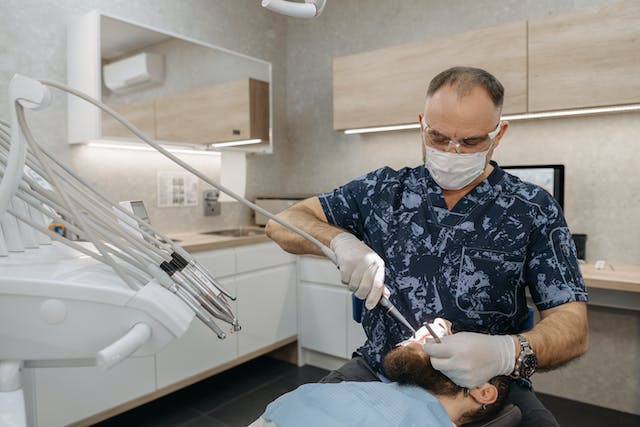
You’ve got a cracked tooth and it’s giving you a real hard time, right? Don’t fret! We’re here to provide you with a detailed guide on what causes tooth cracking, how to spot the symptoms, and how to fix a cracked tooth using the best dental procedures.
You’ll also discover home remedies for temporary relief and ways to prevent future cracks. Let’s help you recover swiftly and comfortably from your cracked tooth ordeal.
Let’s dive in!
Understanding a Cracked or Broken Teeth

Before you can fix a cracked tooth, it’s vital to understand what happens when your tooth chips, crack or fracture. A tooth can crack due to various reasons – biting down on a hard food item, accidental knocks, or even temperature changes in your mouth. When a tooth cracks, the protective outer layer, the enamel, breaks, exposing the sensitive inner layer or dentin.
This exposure can cause a variety of symptoms. You might experience discomfort or pain when you bite down, which may come and go. Sensitivity to hot, cold, or sweet foods and drinks is another common sign. In some cases, you mightn’t feel any symptoms at all, making it tricky to identify the problem.
Why is it crucial to understand this? Well, the longer a cracked tooth goes untreated, the more damage it can cause. In the worst cases, a tooth can break or an infection can occur, leading to a root canal or even tooth extraction. So, it’s essential to recognize the signs early and seek professional help. That’s the first step towards fixing a cracked tooth.
Primary Causes of Tooth Cracking
Often, you’ll find that your tooth cracks due to a handful of common causes. It’s important to understand these factors to potentially prevent future dental issues.
Let’s discuss the primary causes of tooth cracking:
Physical Trauma
This is a leading cause of a cracked or chipped tooth . Physical trauma to the mouth can occur in numerous ways, such as:
– Accidental falls
– Sports-related injuries
– Biting down on hard food or non-food items
Tooth Decay and Cavities
Over time, tooth decay weakens your teeth, making them more susceptible to cracks. Two primary types of decay that contribute to this are:
– Severe cavities that undermine tooth structure
– Advanced gum disease that affects the tooth’s support
Old Fillings
Large, old fillings can cause your teeth to crack. This is because the filling material expands and contracts at a different rate than your tooth, leading to cracks over time.
Teeth Grinding or Clenching (Bruxism)
This habit puts excessive pressure on your teeth, especially when you chew, often leading to cracks.
Recognizing Symptoms of a Cracked or Chipped Tooth
As you strive to maintain your oral health, it’s essential that you’re able to pinpoint the symptoms of a cracked tooth. At first, you mightn’t even notice the crack. But over time, discomfort will likely emerge, especially when eating or drinking hot, cold, or sweet items. You may also experience pain when biting down, as applying pressure can open the crack and irritate the inner soft tissues of the tooth.
Unpredictable toothache is another common symptom. The pain might come and go, making it hard to determine which tooth is causing the discomfort. You might even feel pain without any apparent cause, or an increased sensitivity in the affected area.
Keep in mind that not all cracked teeth show visible signs. You mightn’t see the crack, and it often doesn’t show up on X-rays. Sometimes, a crack is only visible when your tooth is under a certain light or from a specific angle.
Lastly, if you notice swelling around a certain tooth or in your gums, that’s a potential sign of a cracked tooth. So, be vigilant and if you notice any of these symptoms, call an emergency dentist and make an appointment with them quickly.
Dental Procedures on How to Treat a Cracked Tooth
Once you’ve identified potential signs of a cracked tooth, it’s time to explore the various dental procedures that can help rectify the issue. Depending on the severity and location of the crack, your dentist may recommend one or more of the following:
Dental Bonding
This is a simple procedure where a tooth-colored resin is applied to the tooth to fill in the crack and repair the damage. The resin is hardened with a special light, bonding it to the tooth. Once hardened, it’s shaped and polished to match the rest of your teeth. This procedure can be done at the back or front of the tooth.
Root Canal
This is typically necessary for severe cracks that have reached the tooth’s nerve. During this procedure, the nerve and pulp are removed, and the inside of the tooth is cleaned and sealed. A dental crown is often placed over the tooth to protect it and restore its function.
Home Remedies for Temporary Relief if You Have Cracks in the Tooth
While professional dental treatment is crucial for a cracked tooth, there are several home remedies you can use for temporary relief. One of the most effective remedies is rinsing your mouth with warm salt water. This not only soothes the affected area but also reduces inflammation and fights bacteria.
Over-the-counter pain relievers can also provide temporary relief. Just ensure you’re following the recommended dosage. Topical numbing gels or ointments can also be used to numb the area and lessen the pain.
A cold pack applied to the cheek where the cracked tooth is located can help reduce swelling. It’s best to wrap the ice or cold pack in a thin cloth to prevent direct contact with your skin.
You may also consider temporary dental cement available in most drugstores. It can help protect the tooth surface, reducing sensitivity until you can see a dentist.
Preventive Measures Against Tooth Cracking
Despite these temporary remedies, the best approach to dealing with a cracked tooth is preventing it from happening in the first place. Prevention is always better than cure, and this is especially true when it comes to your dental health.
There are certain measures you can take to minimize your risk of cracking a tooth. Some of these include:
Maintaining Good Oral Hygiene
– Brush your teeth twice daily with fluoride toothpaste. This helps to strengthen your tooth enamel, making it less susceptible to cracks.
– Floss daily to remove plaque and food particles from between your teeth, reducing the risk of cavities which can weaken teeth.
Regular Dental Check-ups
– Visit your dentist regularly for routine check-ups. This can help detect early signs of tooth decay and other dental problems that could lead to a cracked tooth.
– Your dentist can also apply sealants or fluoride treatments to strengthen your teeth.
Recovering From a Cracked Tooth Treatment
After getting your cracked tooth treated, you’ll need to follow a specific dental care and recovery regimen to ensure proper healing and prevent further damage. Your dentist will likely provide you with aftercare instructions, but here’s a general idea of what you can expect.
You’ll likely experience some discomfort or sensitivity after the procedure, but don’t worry, it’s normal. Over-the-counter pain relievers and cold compresses will help manage these symptoms. Avoid hard or chewy foods that could potentially harm your treated tooth. Stick to soft foods until the sensitivity and discomfort subside.
Maintaining good oral hygiene is crucial during this period. That means brushing gently but thoroughly twice a day and flossing daily. Keep your mouth clean to stave off infection and speed up the healing process.
Your follow-up visits are also important. They allow your dentist to check your progress and make adjustments if necessary. Don’t skip these appointments. They’re your chance to bring up any concerns or issues you may have encountered since your treatment. You can call Vista Family Dentistry in Waukesha if you need urgent care.

Leave a Reply